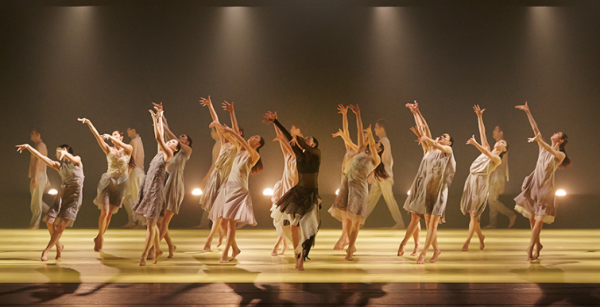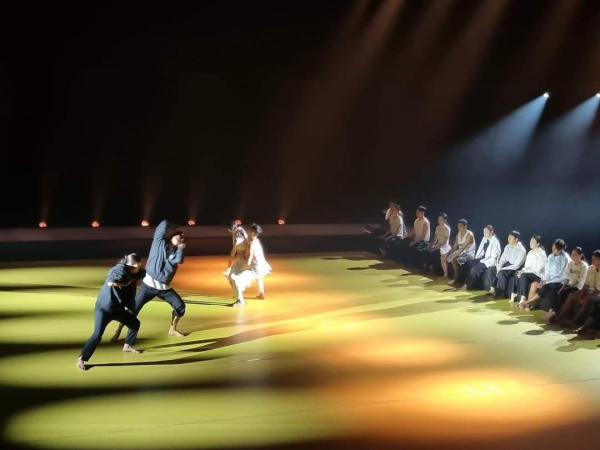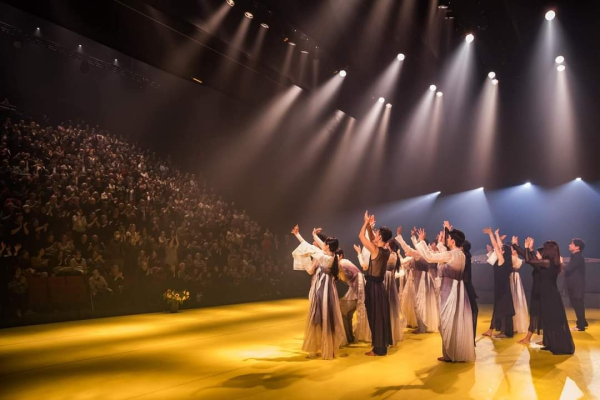[더프리뷰=서울] 편집자 = 지난 9월 22-24일 핀란드 헬싱키 댄스하우스에서 있었던 국립무용단 <회오리> 공연에 대한 현지 언론 Rondo Classic의 리뷰를 번역, 게재한다. 1963년 창간된 Rondo Classic은 북유럽 최대, 핀란드 유일의 클래식 음악 잡지이다. 인쇄 부수 5천500부, 총 독자수 1만7천, 연간 9호 발행.
필자: 하리 쿠시사리(Harri Kuusisaari)
원문에서 영문번역: 시모 바시넨(Simo Vassinen)
영문에서 한글번역: 김수인
마법 같은 한국 작품에서 전통과 현재의 만남

한국 전통에 뿌리를 두고 있다.
정말 멋진 저녁이었다! 한국 국립무용단 초청공연인 테로 사리넨의 <회오리>를 한 마디로 표현하면 그렇다. 이것이 바로 최고의 문화간 만남이다. 이 공연은 옛 전통과 우리 시대를 연결하는 다리를 감동적이고 활력 있게 만들었다.
사리넨은 2014년 서양 안무가 최초로 한국무용을 전문으로 하는 무용단에 자신의 안무를 창작했다. 그는 이미 일본 부토와 같은 형식에 익숙했었기 때문에, 문화 간의 대화라는 개념은 그에게 새로운 것이 아니었다.
<회오리>는 움직임이 호흡에서 시작되고 에너지가 가슴에서 밖으로 뻗어나와 팔을 따라 손바닥과 손가락으로 흐르는 한국 전통에 큰 경의를 표한다. 이것은 사리넨의 그룹 기반 안무의 집단적, 확장적, 순환적 힘을 강조한다. 한국인들에게 새로웠던 것은 개인지향적인 표현이었는데, 이는 특히 독무에서 요구되는 것이다.
무용수들은 두 가지 경향이 공연을 하나로 묶어 긴장이 되는 방식으로 움직임의 언어를 내면화했다. 이런 방식을 통해 동양춤과 서양춤의 경계가 사라진다.
그러나 <회오리>는 춤만으로 이루어지는 것이 아니다. 국악기 연주, 판소리, 그리고 장영규가 작곡한 음악이 중심 역할을 한다. 장성훈의 악기(피리, 가야금, 해금) 사용은 관용적이어서 한국 무속문화에서 비롯된 제의적 느낌을 자아낸다.

주제는 세대 간 관계와 고대와 현대의 충돌로 인한 변화를 중심으로 한다. 회오리 치는 덩어리인 '회오리'의 이미지는 변화의 상징, 사람을 휘두르는 힘, 한국예술의 주술적 유산 등 다양한 방식으로 작업에 등장한다. 나선형 손 움직임은 사리넨 안무어휘의 필수적인 부분이기도 하다.
작품은 터널 같은 프로젝션으로 시작한다. 거기서부터 손들이 그림자처럼 멀리 뻗어나간다. 이 매혹적인 이미지는 미키 쿤투(Mikki Kunttu)의 조명을 무대 마법의 원천으로 초대한다. 첫 번째 장은 바다의 움직이는 덩어리와 조수의 반복적이고 순환적인 특성에서 영감을 받은 그룹 움직임을 기반으로 한다.
흑과 백의 두 커플이 군무 집단에서 떨어져 나타난다. 중간 부분에서 흑색 커플은 조상과 통제의 전통을 상징하고, 백색 커플은 모순과 투쟁하는 현대인을 상징한다. 백색 커플의 표현은 의례적인 공생에 반대하는 힘을 속이 떨릴 정도로 열정적으로 펼쳐보인다. 목요일 공연의 솔리스트들인 김미애, 황용천, 박혜지, 이석준, 박기환은 이러한 긴장감을 절묘하게 표현해냈다.
전환점은 무아지경의 판소리가 등장할 때이다. 이는 과거와 미래를 연결하는 영혼의 노래로 정신적인 분위기를 불러일으킨다. 판소리는 스토리텔링의 장르이지만 장영규는 판소리 파트를 가사 없는 소리로 작곡했다. 텍스트가 작업에 불필요하게 구체적인 의미를 부여했을 수 있기 때문에 이러한 해결책은 이해할 수 있다. 하지만 판소리 명창 이승희는 판소리 본래의 깊이 있고 애절한 소리를 아끼지 않았다.

긴장을 구현했다. (사진제공=손인영)
서양의 어떤 영향이 장영규의 음악에도 약간 보이는데, 특히 미니멀하고 꾸준히 반복되는 비트의 형태가 그러하다. 하지만 그는 거기서 멈추지 않고 각 악기의 독특한 색깔과 특징적 제스처를 끌어들여 더 복잡한 리듬 패턴으로 악기들이 서로 얽히도록 만든다. 이를 통해 악기들은 무용수들과 대화를 하는데, 이들의 대등한 관계가 작품의 강점이다. 음악의 전자 레이어는 훌륭하게 실연되었다. 공연의 연주자들은 나원일, 박순아, 추지윤이었다.
공연 마지막 장의 제목은 '회오리(Vortices)'이다. 이는 갱신, 변화, 발전을 의미한다. 장면은 무용수들의 흔들리는 선으로 시작된다. 그런 다음 가장 흥미로운 부분 중 하나가 나온다. 날개 달린 무용수가 독무를 위해 나오면 음악이 사라지고 무용수가 서라운드 사운드 증폭 날개 스냅으로 자신의 음악을 만든다. 한국 전통의 부채춤을 기반으로 한 이 장면은 작품의 주제와 음악과 춤의 관계에 새로운 차원을 제시한다. 새의 상징주의는 멀리서 들려오는 팬의 외침에 의해 더욱 강화된다. 화려한 수트는 에리카 투루넨이 디자인했다.
마지막 부분은 음악과 춤이 어우러진 본격적인 불꽃 쇼다. 전체 그룹이 강력한 회오리 바람에 모여 다시 한 번 샤머니즘을 메아리치게 만든다. 폴리리듬 음악은 불길에 불을 더하고, 자유와 기쁨의 느낌은 참을 수 없이 커진다.
청중들은 매혹되었다. 이런 것은 거의 본 적이 없다. 공연이 3회 뿐인 게 아쉬울 정도였다. 무용이 갈망하는 새로운 관객을 발굴하는 것은 이러한 종류의 새로운 경험을 통해서이다.

(사진제공=손인영)
Founded in 1963, Rondo Classic is the biggest classical music magazine in the Nordic region, and Finland's only one. Print circulation 5500, total readership 17000, 9 issues per year.
Original text: https://bit.ly/3C9p5BT
RONDO CLASSIC
23 September 2022
Tradition meets the present day in a magical Korean work
Writer: Harri Kuusisaari

What en evening! That is all one can say as the National Dance Company of Korea’s guest performance, Tero Saarinen’s VORTEX comes to a close. This is what it is all about, a meeting of cultures at its best. The performance created a bridge from age-old traditions to our times in a touching and energising way.
Saarinen created his choreography in 2014 as the first Western choreographer of a dance company specialising in traditional Korean dance. He had already previously familiarised himself with e.g. Japanese butoh, so the idea of cultural discourse was not something new.
VORTEX shows great respect to the Korean tradition where movement starts from breath, and energy flows from the chest out along outstretched arms towards the palms and fingers. This highlights the collective, outreaching, and circulating power of Saarinen's group-based dances. What was new for the Koreans was an individual-oriented expression, which is especially called for by the solo scores of the performance.
The dancers have internalised the language of movement in a way that dualism becomes the tension that holds the performance together. The borders between Asian and Western dance disappear.
VORTEX is however not just about dance: performed by musicians using Korean traditional instruments and a pansori singer, the music composed by Young-gyu Jang plays a central role. Jang’s use of instruments (piri, gayageum, and haegeum) is idiomatic, creating a ritual-like feeling stemming from Korean shamanistic culture.

Thematically speaking, the performance centres around inter-generational relationships and the change resulting from the collision of the ancient and the new. The image of a “vortex” – a whirling mass – comes through in the work in many ways, for instance as a symbol of change, as a force that throws people around, as the shamanistic heritage of Korean art. The spiralling hand movements are also an essential part of Tero Saarinen's choreographic vocabulary.
The piece begins with a tunnel-like projection from which hands reach far out as shadows. The captivating image already invites in the role of Mikki Kunttu's lights as a source of stage magic. The first scene is based on group movements inspired by the moving mass of the ocean, and the repetitive and cyclical nature of the tides.
Two couples distance themselves from the collective, a black and a white one. In the middle part, the black couples represent ancestors and a tradition of control, while the white ones stand for a contemporary struggle with contradictions. The expression of the white duo is gut-wrenchingly passionate, as an opposing force to ritualistic togetherness. The soloists in Thursday's performance –– Mi-ea Kim, Youngcheon Hwang, Hae-jee Park, Seogjun Lee, and Kihwan Park achieved to portray this tension superbly.
The turning point of the scene is when a trance-inducing pansori singer enters the stage to conjure up a spiritual atmosphere, a song of the soul that connects the past and the future. Pansori is a genre of storytelling, but Young-guy Jang has composed the singer's parts as vocals without lyrics. The solution is understandable, because a text might have attached unnecessarily concrete meanings to the work. The pansori singer Seunghee Lee did not however hold back in letting out the deep, soulcrushing sounds of the original style.

Some Western influence is also present in Jang's music, especially in the form of a minimalistic, steadily repeating beat, but luckily he doesn't stop there and instead also allows the instruments to intertwine with one another in more intricate rhythm patterns, inviting in the distinct colours and typical gestures of each instrument. This is how the instruments enter into conversation with the dancers, and the equal relationship between them is a strength of the work. The electronic layer of music was executed with good taste. The musicians of the performance were Wonil Na, Soona Park, and Jiyoon Chu.
The choreographer’s title for the last scene of the performance is Vortices, and it deals with renewal, change, and development. The episode starts with the swaying lines of the dancers. Then comes one of the most exciting parts: when a winged dancer comes to perform their solo, the music fades, and the dancer creates their own music with surround-sound amplified wing snaps. It is based on the Korean tradition of fan dance, and again brings a new level to both the theme of the work and the relationship between music and dance. The bird symbolism is further enforced by the distant screams of a fan. The flashy suit was designed by Erika Turunen.
The final part is a full-blown fireworks show of music and dance. The whole group comes together in a powerful whirlwind, once again echoing shamanism. The polyrhythmic music adds fire to the flames, and the feeling of freedom and joy grows irresistible.
The audience is sold. It has hardly ever seen anything like this. It is a pity that there are only three shows. It is with these kinds of new experiences that dance finds the new audience it craves.

(Translation into English by Simo Vassinen)

